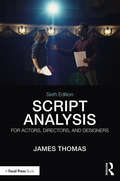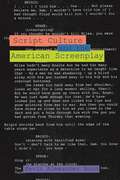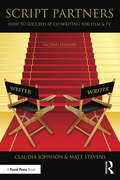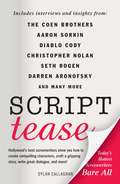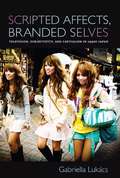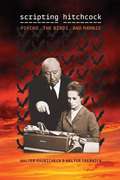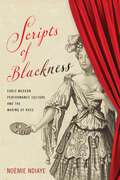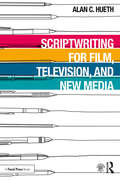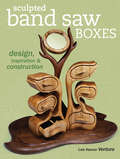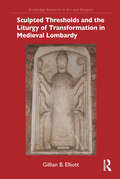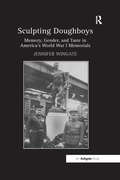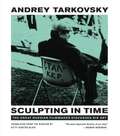- Table View
- List View
Scribble Art: Independent Process Art Experiences for Children (Bright Ideas for Learning #3)
by MaryAnn F KohlEnter the world of creativity where children's imaginations soar.Scribble Art is packed full of a broad spectrum of over 240 open-ended process art activities and ideas. Process art allows a child to participate in an individual and unique art experience using common household items and ordinary art supplies. The purpose of process art is to engage children in the process of creation, rather than focus on a finished product. Process art engages children, builds art confidence, and can be used to introduce art topics to all ages.
Script Analysis for Actors, Directors, and Designers
by James ThomasScript Analysis for Actors, Directors, and Designers teaches the skills of script analysis using a formalist approach that examines the written part of a play to gauge how the play should be performed and designed. Treatments of both classic and unconventional plays are combined with clear examples, end-of-chapter questions, and stimulating summaries that will allow actors, directors and designers to immediately incorporate the concepts and processes into their theatre production work. Now thoroughly revised, the fifth edition contains a new section on postmodernism and postdramatic methods of script analysis, along with additional material for designers.
Script Analysis for Actors, Directors, and Designers
by James ThomasScript Analysis for Actors, Directors, and Designers, Sixth Edition teaches the skills of script analysis using a formalist approach that examines the written part of a play to evaluate its potentials for performance and production. This new edition offers a more streamlined experience for the reader and features new and revised content, such as a fully updated chapter on postmodern drama, new sections on Associative Thinking and Ambiguous Terms in the Introduction, and revised appendices featuring The Score of a Role and expanded treatments of Functional Analysis for Designers and Further Questions for Script Analysis. Explorations of both classic and unconventional plays are combined with clear examples, end-of-chapter summaries, and stimulating questions that will allow actors, directors, and designers to immediately incorporate the concepts and processes into their theatre production work. An excellent resource for students of Acting, Script Analysis, Directing, and Playwriting courses, this book provides the tools to effectively bring a script to life on stage.
Script Analysis for Actors, Directors, and Designers
by James ThomasScript Analysis for Actors, Directors, and Designers, Seventh Edition, teaches the skills of script analysis using a formalist approach that examines the written part of a play to evaluate its potentials for performance and production. This new edition features new and revised content, including an analysis of two new plays, Kalidasa’s Shakuntala and Federico Garcia Lorca’s The House of Bernarda Alba; information for the theatre designer integrated in chapters throughout the book; and an expanded appendix on critical approaches to script analysis. Explorations of both classic and unconventional plays are combined with clear examples, end-of-chapter summaries, and stimulating questions that will allow actors, directors, and designers to immediately incorporate the concepts and processes into their theatre production work. An excellent resource for students of acting, script analysis, directing, playwriting, and stage design courses, this book provides the tools to effectively bring a script to life on stage.
Script Analysis: Deconstructing Screenplay Fundamentals
by James BangA comprehensive step-by-step guide to deconstructing screenplay fundamentals, this book will allow readers to understand the elements, functions and anatomy of a screenplay. Not only will this book enable readers to accomplish a thorough analysis of a screenplay and understand the dramatic elements and their functions, but screenwriters will be able to apply these steps to their own writing. The book explores theme and premise, provides an in-depth study of character development, and breaks down the dramatic elements needed to construct a solid screenplay. It provides examples of the three-act structure, The Hero’s Journey, and the sequence method. Furthermore, it explores how the main plot and subplots are used in a storyline and discusses the importance of setting. Finally, it reveals screenwriting techniques and tools used by professional screenwriters, such as dramatic irony, reversal, and setup/payoff. To connect with a broad range of readers, the case studies used in this book are mainly from contemporary films, including Get Out (2017), Lady Bird (2018), The Dark Knight (2008), Toy Story (1994), Parasite (2019) and Whiplash (2014). Readers will understand how professional screenwriters use fundamental elements to construct, shape, develop, and tell a visual story. After reading this book, readers will comprehend the components critical to developing a screenplay. Ideal for students of screenwriting and filmmaking who want to better understand how to comprehensively analyze a screenplay, as well as professional screenwriters who want to utilize this method to better develop their own scripts.
Script Culture and the American Screenplay
by Kevin BoonBy considering the screenplay as a literary object worthy of critical inquiry, this volume breaks new ground in film studies.
Script Development: Critical Approaches, Creative Practices, International Perspectives
by Craig Batty Stayci TaylorThis book offers the first international look at how script development is theorised and practiced. Drawing on interviews, case studies, discourse analysis, creative practices and industry experiences, it brings together scholars and practitioners from around the world to offer critical insights into this core, but often hidden, aspect of screenwriting and screen production. Chapters speculate and reflect upon how creative, commercial and social practices – in which ideas, emotions, people and personalities combine, cohere and clash – are shaped by the practicalities, policies and rapid movements of the screen industry. Comprising two parts, the book first looks ‘into’ script development from a theoretical perspective, and second looks ‘out from’ the practice to form practitioner-led perspectives of script development. With a rising interest in screenwriting and production studies, and an increased appetite for practice-based research, the book offers a timely mapping of the terrain of script development, providing rich foundations for both study and practice.
Script Partners: How to Succeed at Co-Writing for Film & TV
by Matt Stevens Claudia JohnsonSome of the greatest movies and television series have been written by script partners. Script Partners, Second Edition brings together the experience, knowledge, and winning techniques of Hollywood’s most productive partnerships—including Lucy Alibar & Benh Zeitlin (Beasts of the Southern Wild ), Craig Borten & Melisa Wallack (Dallas Buyers Club), and Andrew Reich & Ted Cohen (Friends). Established and aspiring screenwriters will learn how to pick the right partner and the right project, co-create character and story structure, co-draft and revise a script, collaborate in film school and in the film industry, and manage both the creative and business sides of partnerships.
Script Supervising and Film Continuity
by Pat P MillerThis definitive handbook explains how a script is transformed into a motion picture or television program. Readers will learn the methodology and craft of the script supervisor, who ensures that the continuity of a film, its logical progression, is coherent. The book teaches all vital script supervising functions, including how to: .prepare, or "break down" a script for shooting .maintaining screen direction and progression .matching scenes and shots for editing .cuing actors .recording good takes and prints preparing time and log sheets for editingThis revision of an industry classic has been updated to reflect changes in the film industry in recent years, including the use of electronic media in the script supervisor's tasks. While it is written for the novice script writer, it can serve as a valuable resource for directors, film editors, scriptwriters and cinematographers.
Script Tease: Today's Hottest Screenwriters Bare All
by Dylan CallaghanThe Newest Screenwriting SecretsWhat do an erstwhile stripper, an ex–gambling addict, and a stoned Canadian teenager have in common? They wrote your favorite movies, and they're not who you'd expect.Diablo Cody (Juno), Darren Aronofsky (The Wrestler), and Seth Rogan (Superbad) are among the scribes interviewed in Script Tease, your main line to the most current screenwriting wisdom. Their funny, even touching tales of how they made it despite the odds will give you a revealing look into what it really takes to get into the industry.With the guidance of recent greats like Aaron Sorkin (The Social Network) and the Coen Brothers (True Grit), you will learn how to hone your craft and make it in an industry where only the best succeed.
Scripted Affects, Branded Selves: Television, Subjectivity, and Capitalism in 1990s Japan
by Gabriella LukácsIn Scripted Affects, Branded Selves, Gabriella Lukcs analyzes the development of a new primetime serial called "trendy drama" as the Japanese television industry's ingenious response to market fragmentation. Much like the HBO hit Sex and the City, trendy dramas feature well-heeled young sophisticates enjoying consumer-oriented lifestyles while managing their unruly love lives. Integrating a political-economic analysis of television production with reception research, Lukcs suggests that the trendy drama marked a shift in the Japanese television industry from offering story-driven entertainment to producing lifestyle-oriented programming. She interprets the new televisual preoccupation with consumer trends not as a sign of the medium's downfall, but as a savvy strategy to appeal to viewers who increasingly demand entertainment that feels more personal than mass-produced fare. After all, what the producers of trendy dramas realized in the late 1980s was that taste and lifestyle were sources of identification that could be manipulated to satisfy mass and niche demands more easily than could conventional marketing criteria such as generation or gender. Lukcs argues that by capitalizing on the semantic fluidity of the notion of lifestyle, commercial television networks were capable of uniting viewers into new affective alliances that, in turn, helped them bury anxieties over changing class relations in the wake of the prolonged economic recession.
Scripting Cultures
by Mark BurryWith scripting, computer programming becomes integral to the digital design process. It provides unique opportunities for innovation, enabling the designer to customise the software around their own predilections and modes of working. It liberates the designer by automating many routine aspects and repetitive activities of the design process, freeing-up the designer to spend more time on design thinking. Software that is modified through scripting offers a range of speculations that are not possible using the software only as the manufacturers intended it to be used. There are also significant economic benefits to automating routines and coupling them with emerging digital fabrication technologies, as time is saved at the front-end and new file-to-factory protocols can be taken advantage of. Most significantly perhaps, scripting as a computing program overlay enables the tool user (designer) to become the new tool maker (software engineer). Though scripting is not new to design, it is only recently that it has started to be regarded as integral to the designer's skill set rather than a technical speciality. Many designers are now aware of its potential, but remain hesitant. This book treats scripting not only as a technical challenge, requiring clear description, guidance and training, but also, and more crucially, answers the question as to why designers should script in the first place, and what the cultural and theoretical implications are.This book:Investigates the application of scripting for productivity, experimentation and design speculation.Offers detailed exploration of the scripting of Gaudí's final realised design for the Sagrada Família, leading to file-to-factory digital fabrication.Features projects and commentary from over 30 contemporary scripting leaders, including Evan Douglis, Marc Fornes, Sawako Kaijima, Achim Menges, Neri Oxman, Casey Reas and Hugh Whitehead of Foster + Partners.
Scripting Hitchcock: Psycho, The Birds, and Marnie
by Walter Srebnick Walter RaubicheckNominated for a nonfiction Edgar Allan Poe Award from the Mystery Writers of America, Scripting Hitchcock explores the collaborative process between Alfred Hitchcock and the screenwriters he hired to write the scripts for three of his greatest films: Psycho, The Birds, and Marnie. Drawing from extensive interviews with the screenwriters and other film technicians who worked for Hitchcock, Walter Raubicheck and Walter Srebnick illustrate how much of the filmmaking process took place not on the set or in front of the camera, but in the adaptation of the sources, the mutual creation of plot and characters by the director and the writers, and the various revisions of the written texts of the films. Hitchcock allowed his writers a great deal of creative freedom, which resulted in dynamic screenplays that expanded traditional narrative and defied earlier conventions. Critically examining the question of authorship in film, Raubicheck and Srebnick argue that Hitchcock did establish visual and narrative priorities for his writers, but his role in the writing process was that of an editor. While the writers and their contributions have generally been underappreciated, this study reveals that all the dialogue and much of the narrative structure of the films were the work of screenwriters Jay Presson Allen, Joseph Stefano, and Evan Hunter. The writers also shaped American cultural themes into material specifically for actors such as Janet Leigh, Tippi Hedren, and Tony Perkins. This volume gives due credit to those writers who gave narrative form to Hitchcock's filmic vision.
Scripting Media
by Frank Barnas Marie BarnasBringing together professional standards, practices, and jargon from across the industry, Scripting Media provides a complete overview of writing for divergent forms of media. While some forms of media writing have been honed and standardized over generations, others demand new ways of thinking and collaborating. Covering traditional forms of scriptwriting, such as news, advertising, and film scripting, as well as newer and more emerging areas of social media and virtual reality, this book is designed to prepare readers for the varying formats, styles, and techniques specific to each medium. Each chapter contains a list of key terms, an historical overview of the area, and technical specifications for students to be aware of. Exercises, essay prompts, and online links help reinforce students’ knowledge and provide avenues for private study. Written in an accessible and engaging style by two renowned media practitioners, authors, and teachers, Scripting Media is essential reading for students approaching media writing for the first time.
Scripting Media
by Frank Barnas Marie BarnasBringing together professional standards, practices, and jargon from across the industry, Scripting Media provides a complete overview of writing for divergent forms of media.While some forms of media writing have been honed and standardized over generations, others demand new ways of thinking and collaborating. Covering traditional forms of scriptwriting, such as news, advertising, and film scripting, as well as newer and more emerging areas of social media and virtual reality, this book is designed to prepare readers for the varying formats, styles, and techniques specific to each medium. Each chapter contains a list of key terms, an historical overview of the area, and technical specifications for students to be aware of. Exercises, essay prompts, and online links help reinforce students’ knowledge and provide avenues for private study.Written in an accessible and engaging style by two renowned media practitioners, authors, and teachers, Scripting Media is essential reading for students approaching media writing for the first time.
Scripting the Environment: Oil, Democracy and the Sands of Time and Space (Palgrave Studies in Media and Environmental Communication)
by Geo TakachThis volume explores how to engage audiences both beyond and within the academy more deeply in environmental research through arts-based forms. It builds on a multi-pronged case study of scripts for documentary film, audio-visual and stage formats, focusing on how the identity of a place is constructed and contested in the face of environmental concerns around fossil-fuel extraction in a globalized, visual society--and specifically on the rising, international public-relations war over Alberta’s stewardship of the tar sands. Each script is followed by discussion of the author’s choices of initiating idea, research sources, format, voices, world of the story, structure and visual style, and other notes on the convergence of synthesis, analysis and (re)presentation in the script. Included are lively analysis and commentary on screenwriting and playwriting theory, the creation and dissemination of the scripts, and reflections to ground a proposed framework for writing eco-themed scripts for screen, audio-visual and stage formats.
Scripts of Blackness: Early Modern Performance Culture and the Making of Race (RaceB4Race: Critical Race Studies of the Premodern)
by Noémie NdiayeScripts of Blackness shows how the early modern mass media of theatre and performance culture at-large helped turn blackness into a racial category, that is, into a type of difference justifying emerging social hierarchies and power relations in a new world order driven by colonialism and capitalism.In this book, Noémie Ndiaye explores the techniques of impersonation used by white performers to represent Afro-diasporic people in England, France, and Spain in the sixteenth and seventeenth centuries, using a comparative and transnational framework. She reconstructs three specific performance techniques—black-up (cosmetic blackness), blackspeak (acoustic blackness), and black dances (kinetic blackness)—in order to map out the poetics of those techniques, and track a number of metaphorical strains that early modern playtexts regularly associated with them. Those metaphorical strains, the titular scripts of blackness of this book, operated across national borders and constituted resources, as they provided spectators and participants with new ways of thinking about the Afro-diasporic people who lived or could/would ultimately live in their midst.Those scripts were often gendered and hinged on notions of demonization, exclusion, exploitation, animalization, commodification, sexualization, consensual enslavement, misogynoir, infantilization, and evocative association with other racialized minorities. Scripts of Blackness attempts to grasp the stories that Western Europeans told themselves through performative blackness, and the effects of those fictions on early modern Afro-diasporic subjects.
Scriptwriting for Film, Television and New Media
by Alan C. HuethWhat are the foundations of scriptwriting? Why do some scripts gain more prestige than others? How do you write a script and get it noticed? Scriptwriting for Film, Television and New Media answers these questions and more, offering a comprehensive introduction to writing scripts for film, television, the Internet, and interactive multimedia. Author Alan C. Hueth explains not just how to write, but how to think and apply the fundamental principles of screenwriting to multiple platforms and genres. This includes chapters on numerous script formats, including drama and comedy in film and TV, short films, commercials and PSAs, news and sports, interview shows, documentaries, reality shows, and corporate and educational media, including interactive multimedia. This book also addresses legal and ethical issues, how to become a professional scriptwriter, and a section on production language that provides helpful explanations of how camera, locations, visual and audio effects combine on screen to engage and sustain viewer attention, and, consequently, how to improve scriptwriting technique. The book features numerous case studies and detailed examples, including chapter by chapter exercises, plot diagrams, quick-look and learn tables that assist readers to quickly understand genre related script elements, and in-depth script close-ups to examine precisely how writers utilize the principles and elements of drama to create a successful script. It is also supported by a comprehensive companion website with further case studies, assignments, video clips, and examples of films and programs discussed in the book. Scriptwriting for Film, Television, and New Media is ideal for aspiring scriptwriters and anyone wanting to broaden their understanding of how successful scripts are created.
Scriptwriting for Theatre and Screen: A Practical Guide
by Richard StockwellScriptwriting for Theatre and Screen: A Practical Guide is an introduction designed to help readers understand the nature of dramatic scriptwriting and quickly guide them to a place where they can write, first a short play, and then a short screenplay.The book clearly points out not only the differences between writing for the stage and writing for the screen, but also the shared skills and the fundamental dramatic principles that unite them. The two sections (Theatre Writing and Screenwriting) are connected by a bridging chapter that explores similarities and differences between the two media. The chapters are arranged with a short introductory essay on topics such as generating ideas, structure, character, modes of address, empathy, status, visual writing, and revising and editing, followed by practical exercises with exemplar responses – including a sample short play and film. Two additional chapters address how to approach writing a self-reflexive commentary, explore how the skills covered can be applied to writing for television, and explain other skills a writer might need to develop when working in this industry.This complete introduction to writing dramatic scripts is intended for students of playwriting and screenwriting but is also suitable for all writers new to these areas and interested in developing their skills.
Scriptwriting for Web Series: Writing for the Digital Age
by Marie Drennan Yuri Baranovsky Vlad BaranovskyScriptwriting for Web Series: Writing for the Digital Age offers aspiring writers a comprehensive how-to guide to scriptwriting for web series in the digital age. Containing in-depth advice on writing both short- and long-form webisodes as part of a series, as well as standalone pieces, it goes beyond the screenwriting process to discuss production, promotion and copyright in order to offer a well-rounded guide to creating and distributing a successful web series. Written in a friendly, readable and jargon-free style by an experienced scriptwriting professor and two award-winning web series creators, it offers invaluable professional insights, as well as examples from successful series, sample scripts and interviews with key series creators, writers and industry professionals.
Sculpted Band Saw Boxes: Design, Inspiration & Construction
by Lois VenturaThinking inside the box!Making band saw boxes allows woodworkers creativity that just can't be found in other types of woodworking. Of the band-saw box builders working today, few can claim the sculpted artistry of Lois Ventura's work.With Sculpted Band Saw Boxes you'll find step-by-step instructions for nine new designs, patterns for another 20 band saw box projects, plus a stunning gallery of Ventura's boxes guaranteed to inspire you to stretch your creative muscles and create your own original box designs.
Sculpted Thresholds and the Liturgy of Transformation in Medieval Lombardy (Routledge Research in Art and Religion)
by Gillian B. ElliottThis book explores the issue of ecclesiastical authority in Romanesque sculpture on the portals and other sculpted “gateways” of churches in the north Italian region of Lombardy. Gillian B. Elliott examines the liturgical connection between the ciborium over the altar (the most sacred threshold inside the church), and the sculpted portals that appeared on church exteriors in medieval Lombardy. In cities such as Milan, Civate, Como, and Pavia, the liturgy of Saint Ambrose was practiced as an alternative to the Roman liturgy and the churches were constructed to respond to the needs of Ambrosian liturgy. Not only do the Romanesque churches in these places correspond stylistically and iconographically, but they were also linked politically in an era of intense struggle for ultimate regional authority. The book considers liturgical and artistic links between interior church furnishings and exterior church sculptural programs, and also applies new spatial methodologies to the interior and exterior of churches in Lombardy. The book will be of interest to scholars working in art history, medieval studies, architectural history, and religious studies.
Sculpted Thresholds and the Liturgy of Transformation in Medieval Lombardy (Routledge Research in Art and Religion)
by Gillian B. ElliottThis book explores the issue of ecclesiastical authority in Romanesque sculpture on the portals and other sculpted “gateways” of churches in the north Italian region of Lombardy. Gillian B. Elliott examines the liturgical connection between the ciborium over the altar (the most sacred threshold inside the church), and the sculpted portals that appeared on church exteriors in medieval Lombardy. In cities such as Milan, Civate, Como, and Pavia, the liturgy of Saint Ambrose was practiced as an alternative to the Roman liturgy and the churches were constructed to respond to the needs of Ambrosian liturgy. Not only do the Romanesque churches in these places correspond stylistically and iconographically, but they were also linked politically in an era of intense struggle for ultimate regional authority. The book considers liturgical and artistic links between interior church furnishings and exterior church sculptural programs, and also applies new spatial methodologies to the interior and exterior of churches in Lombardy. The book will be of interest to scholars working in art history, medieval studies, architectural history, and religious studies.
Sculpting Doughboys: Memory, Gender, and Taste in America's World War I Memorials
by Jennifer WingateRedressing the neglect of World War I memorials in art history scholarship and memory studies, Sculpting Doughboys considers the hundreds of sculptures of American soldiers that dominated the nation's sculptural commemorative landscape after World War I. To better understand these 'doughboys', the name given to both members of the American Expeditionary Forces and the memorials erected in their image, this volume also considers their sculptural alternatives, including depictions of motherhood, nude male allegories, and expressions of anti-militarism. It addresses why doughboy sculptures came to occupy such a significant presence in interwar commemoration, even though art critics objected to their unrefined realism, by considering the social upheavals of the Red Scare, America's burgeoning consumer and popular culture, and the ambitions and idiosyncrasies of artists and communities across the country. In doing so, this study also highlights the social and cultural tensions of the period as debates grew over art's changing role in society and as more women and immigrant sculptors vied for a place and a voice in America's public sphere. Finally, Sculpting Doughboys addresses the fate of these memorials nearly a century after they were dedicated and poses questions for reframing our relationship with war memorials today.
Sculpting in Time: Reflections on the Cinema
by Andrey Tarkovsky Kitty Hunter-BlairAndrey Tarkovsky, the genius of modern Russian cinema—hailed by Ingmar Bergman as "the most important director of our time"—died an exile in Paris in December 1986. In Sculpting in Time, he has left his artistic testament, a remarkable revelation of both his life and work. Since Ivan's Childhood won the Golden Lion at the Venice Film Festival in 1962, the visionary quality and totally original and haunting imagery of Tarkovsky's films have captivated serious movie audiences all over the world, who see in his work a continuation of the great literary traditions of nineteenth-century Russia. Many critics have tried to interpret his intensely personal vision, but he himself always remained inaccessible. In Sculpting in Time, Tarkovsky sets down his thoughts and his memories, revealing for the first time the original inspirations for his extraordinary films—Ivan's Childhood, Andrey Rublyov, Solaris, The Mirror, Stalker, Nostalgia, and The Sacrifice. He discusses their history and his methods of work, he explores the many problems of visual creativity, and he sets forth the deeply autobiographical content of part of his oeuvre—most fascinatingly in The Mirror and Nostalgia. The closing chapter on The Sacrifice, dictated in the last weeks of Tarkovsky's life, makes the book essential reading for those who already know or who are just discovering his magnificent work.


